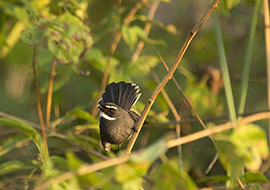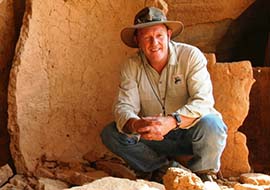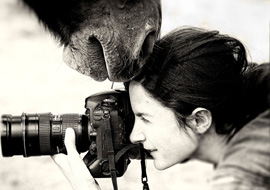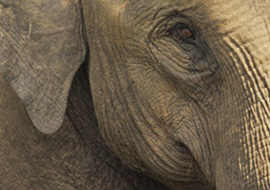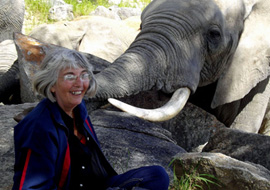
Even today, after more than ten years of observing elephants in their wilderness, I cannot just stop myself from starring at them at amuse.
The most majestic and graceful animal, I cannot even imagine how some of our Indian jungle would look without their presence. No doubt, like human, it is very difficult to understand their moods – even for a person who has spent several years in the field studying them.
 Every one of us has our own perception of describing this mystic-majestic; there is a tale of six blind men who went to study an elephant who had their own way of describing the elephant. The first blind man felt it’s hard and sturdy side, called it is similar to wall. The second felt the tusk and pronounced the elephant similar to a spear. The third felt the trunk and described the animal as snake like. The fourth encountered the knee and thought the elephant was like the tree.The fifth touched the ear and said it was a like fan. Finally the sixth felt the tail and described the elephant similar to a rope.
Every one of us has our own perception of describing this mystic-majestic; there is a tale of six blind men who went to study an elephant who had their own way of describing the elephant. The first blind man felt it’s hard and sturdy side, called it is similar to wall. The second felt the tusk and pronounced the elephant similar to a spear. The third felt the trunk and described the animal as snake like. The fourth encountered the knee and thought the elephant was like the tree.The fifth touched the ear and said it was a like fan. Finally the sixth felt the tail and described the elephant similar to a rope.
Though none of them had actually seen the elephant and each was basing his description on only a small, selective perception, each one was prepared to vigorously dispute the conviction of his fellows. Another question, that might arise in our minds, exactly which is elephant’s strange feature is the most unique? Some of them, though even the hair, skin, feet are also considered as unique are given below:
The Trunk – Sometime around 50 to 45 B.C , a Roman poet named Lucre Tius described the elephant as the “beast that hath between his eyes, a serpent for a hand” . This magnificent adjunct is a boneless, muscular elongation of the upper lip and the nose and is composed of forty thousand muscles. The trunk is powerful enough to kill a lion with single blow; the finger lobes at the tip of the trunk are still adept enough to pluck a feather from the ground. Nearly all the fifty gallons of water that an adult elephant might consume in a day is drawn with this trunk. Not to forget the mud bath that they do using their trunks to protect themselves from the insects.
The Tusks – An idiosyncratic feature of the elephant which is also the main cause of the animals peril to the brink of extinction. For ages, the tusks of ivory have been used for sculpting beautiful ornaments which is carved on them. The tusks are enlarged and protruding incisor teeth; Ivory is a blend of enamel, dentine material beneath, cartilage and mineral deposits.
The Teeth – Equipped with four molars, one on each upper and lower jaws. Over years, these molars wear out and are replaced by others that move forward in the mouth.
The Ears – Packed with blood vessels and when flapped, quickly lowers the animal’s body temperature by swiftly circulating blood. When an elephant senses something out of ordinary within close proximity, one of the indications of its agitated curiosity is rapid ear flapping.
 Elephants exist in a highly ordered, closely knit, matriarchal world. A herd that has not been affected by the wrath of poaching consists of generally a dozen or more that are led by one mature female. A herd generally consists of generation of female from grand mother to newly born grandchild. Bulls (male elephant) are generally forced to leave the herd when they reach the puberty. The bulls join other group of bulls after coming into contact with them.
Elephants exist in a highly ordered, closely knit, matriarchal world. A herd that has not been affected by the wrath of poaching consists of generally a dozen or more that are led by one mature female. A herd generally consists of generation of female from grand mother to newly born grandchild. Bulls (male elephant) are generally forced to leave the herd when they reach the puberty. The bulls join other group of bulls after coming into contact with them.
When any of the group within a clan happens to meet in their daily wanderings, there is so much excitement that’s seems like a family reunion. They rush towards each other, filling the air with their whispers. Elephants are more known for their way of greeting – the ritual begins by a mutual touching with the trunk of each others glands on the cheeks and temples. Usually scarcity of food and water tends to splinter the size of the herd, however family bondage is always observed.
Grief – one has to see it to be a believer in the ability of the great animals to feel emotions. When a dying animal first falls, other members of the herd will immediately form the traditional circle around her. Only when they are sure that the there is no life in the deal elephants body, the heard will begin to feed nearby; However one can still notice the sense of restlessness in them in every action. Every member of the family will stop by and mourn near the place of death in the years to come, respecting the life of their family member or a fellow clan that once existed.
 Raising the Young – Every member of the family shares various duties in rearing a young elephant. Sometimes pregnant cows, split from the family and return after sometime with the new born calf. However first –time mothers receive significant assistance from the comrades. When there is a difficult birth, the comrades help in removing the fetal membrane around the baby and help the calf to get to its feet. The elephants are also known to keep the place where the cow supposes to deliver clean and surfaced. The calf learns most of its life surviving techniques from its herd members.
Raising the Young – Every member of the family shares various duties in rearing a young elephant. Sometimes pregnant cows, split from the family and return after sometime with the new born calf. However first –time mothers receive significant assistance from the comrades. When there is a difficult birth, the comrades help in removing the fetal membrane around the baby and help the calf to get to its feet. The elephants are also known to keep the place where the cow supposes to deliver clean and surfaced. The calf learns most of its life surviving techniques from its herd members.
Birth – The cow generally becomes pregnant for the first time at about the age of ten. On an average, if a cow does not succumb to poaching, gives birth to about seven to eight offspring. The gestation period is about twenty-two months and they generally give birth to one calf.
Musth – Is a period that ranges in bulls that ranges from few days to months. The bulls are aggressive towards anything that is close to their vicinity. During masth, the glands at the cheek and temple of the bull secrete a foul-like smelling fluid that can be seen on animals face from quite a distance. Usually musth seems to play a role in mating; the bulls are more active in searching for a cow.
I know that the numbers of the elephant population has gone down. I also know that the reason for they coming to the threshold of extinction is us and we are aware if it as well. All we need to do is stop using the products made from them and respect them for their existence. This article is only an introduction to showcase some of their physical characteristics and what makes them the special, though they are special in all ways. The elephants have shared with us war and peace, ordeal and joy, neglect and ceremony. It is still a most evocative symbol around which our History/ heritage revolves. Let us continue to make this as our future – not for war, but for peace, Elephants and Human!


